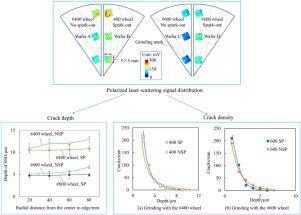当前位置:
X-MOL 学术
›
J. Mater. Process. Tech.
›
论文详情
Our official English website, www.x-mol.net, welcomes your feedback! (Note: you will need to create a separate account there.)
Two-dimensional Detection of Subsurface Damage in Silicon Wafers with Polarized Laser Scattering
Journal of Materials Processing Technology ( IF 6.3 ) Pub Date : 2020-10-01 , DOI: 10.1016/j.jmatprotec.2020.116746 Jingfei Yin , Qian Bai , Han Haitjema , Bi Zhang
Journal of Materials Processing Technology ( IF 6.3 ) Pub Date : 2020-10-01 , DOI: 10.1016/j.jmatprotec.2020.116746 Jingfei Yin , Qian Bai , Han Haitjema , Bi Zhang

|
Abstract This study proposes a polarized laser scattering (PLS) method for detection of the two-dimensional distribution of the grinding-induced subsurface damage (SSD). This study also uses two destructive methods to observe the distribution of SSD in the ground silicon wafers by cross-sectional microscopy and by layer-by-layer microscopy. An experimental investigation is arranged for detecting the two-dimensional damage from diamond wheel grinding of silicon wafers through wafer sample preparation and SSD observations with the cross-sectional and layer-by-layer microcopy. It also includes PLS detection of the ground silicon wafers for SSD information. The results show that both the depth of SSD and the crack density contribute to the PLS detection signals. The study reveals the characteristics of the PLS detection, which illustrates the potential application of the PLS method to in-process detection.
中文翻译:

用偏振激光散射二维检测硅片表面损伤
摘要 本研究提出了一种偏振激光散射(PLS)方法,用于检测磨削引起的亚表面损伤(SSD)的二维分布。本研究还采用了两种破坏性方法,分别通过横截面显微镜和逐层显微镜观察研磨硅片中SSD的分布情况。通过晶圆样品制备和SSD观察,通过横截面和逐层显微镜观察,检测金刚石砂轮磨削硅片二维损伤的实验研究。它还包括对用于 SSD 信息的研磨硅晶片进行 PLS 检测。结果表明,SSD 的深度和裂纹密度都对 PLS 检测信号有贡献。研究揭示了PLS检测的特点,
更新日期:2020-10-01
中文翻译:

用偏振激光散射二维检测硅片表面损伤
摘要 本研究提出了一种偏振激光散射(PLS)方法,用于检测磨削引起的亚表面损伤(SSD)的二维分布。本研究还采用了两种破坏性方法,分别通过横截面显微镜和逐层显微镜观察研磨硅片中SSD的分布情况。通过晶圆样品制备和SSD观察,通过横截面和逐层显微镜观察,检测金刚石砂轮磨削硅片二维损伤的实验研究。它还包括对用于 SSD 信息的研磨硅晶片进行 PLS 检测。结果表明,SSD 的深度和裂纹密度都对 PLS 检测信号有贡献。研究揭示了PLS检测的特点,

























 京公网安备 11010802027423号
京公网安备 11010802027423号